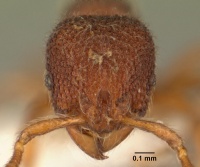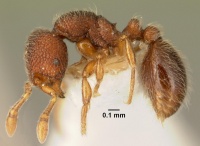Tetheamyrma
| Tetheamyrma | |
|---|---|

| |
| Tetheamyrma subspongia | |
| Scientific classification | |
| Kingdom: | Animalia |
| Phylum: | Arthropoda |
| Class: | Insecta |
| Order: | Hymenoptera |
| Family: | Formicidae |
| Subfamily: | Myrmicinae |
| Tribe: | Crematogastrini |
| Alliance: | Mayriella genus group |
| Genus: | Tetheamyrma Bolton, 1991 |
| Type species | |
| Tetheamyrma subspongia | |
| Diversity | |
| 2 species (Species Checklist, Species by Country) | |
The genus, comprised of two species, appears to be restricted to forests in good condition on Borneo and in the Philippines.
Identification
General and Buenavente (2018), changes in genus definition from Bolton (1991) are numbered
Monomorphic ants. Head and mesosoma densely rugoreticulate dorsally, laterally, and ventrally, except for smooth genal bridge. Head pilosity composed of fine hairs of varying lengths and flexibility.
Antennae with 10 - 11 segments, with very large 2-segmented apical club (1). Antennal scape short, just reaching or barely exceeding posterior margin of compound eye. Antennal scrobe absent. Compound eye small, located laterally, just forward of midlength of head. Frontal carina present or absent (2). Frontal lobe wide, completely concealing torulus, wider than median part of clypeus inserted between them. Posterior median clypeus narrowly inserted between frontal lobes. Anterior clypeus medially with a pair of setae straddling midpoint. Median clypeus narrowly bicarinate. Mandible triangular.
In lateral view, palp formula 2,2 (undissected). Mesosoma in profile with smoothly convex dorsal outline. Metanotal groove impressed or obsolete (3). Propodeum with short, acute, triangular spines. Infradental lamella between propodeal spine and metapleural lobe present or absent (4). Propodeal lobe low and rounded. Propodeal spiracle conspicuous, variable in location. Petiole sculptured. Anteroventral petiolar process present. Anteroventral postpetiolar process present or absent (5). Spongiform tissue on venter of petiole, postpetiole, and first gastral sternite present or absent (6). Spine absent from mesotibia and metatibia. Sting simple and functional.
Distribution
Sabah, Malayasia.
Distribution and Richness based on AntMaps
Species by Region
Number of species within biogeographic regions, along with the total number of species for each region.
| Afrotropical Region | Australasian Region | Indo-Australian Region | Malagasy Region | Nearctic Region | Neotropical Region | Oriental Region | Palaearctic Region | |
|---|---|---|---|---|---|---|---|---|
| Species | 0 | 0 | 2 | 0 | 0 | 0 | 0 | 0 |
| Total Species | 2851 | 1736 | 3047 | 932 | 840 | 4391 | 1767 | 2925 |
Biology
Spongiform material on the waist segments and base of the gaster ventrally was previously known only in the tribe Dacetini and the non-dacetine genus Dacetinops. Tetheamyrma is not related to either of these and thus represents a third independent evolution of this feature, whose function remains unknown.
Life History Traits
- Mean colony size: ? (Greer et al., 2021)
- Compound colony type: not parasitic (Greer et al., 2021)
- Nest site: hypogaeic (Greer et al., 2021)
- Diet class: ? (Greer et al., 2021)
- Foraging stratum: subterranean/leaf litter (Greer et al., 2021)
Castes
Morphology
Worker Morphology
 Explore: Show all Worker Morphology data or Search these data. See also a list of all data tables or learn how data is managed.
Explore: Show all Worker Morphology data or Search these data. See also a list of all data tables or learn how data is managed.
• Antennal segment count: 11 • Antennal club: 2 • Palp formula: 2,2 • Total dental count: 5-8 • Spur formula: 0, 0 • Eyes: 11-100 ommatidia • Pronotal Spines: absent • Mesonotal Spines: absent • Propodeal Spines: dentiform • Petiolar Spines: absent • Caste: none or weak • Sting: present • Metaplural Gland: present • Cocoon: absent
Male Morphology
 Explore: Show all Male Morphology data or Search these data. See also a list of all data tables or learn how data is managed.
Explore: Show all Male Morphology data or Search these data. See also a list of all data tables or learn how data is managed.
• Caste unknown
Phylogeny
| Myrmicinae |
| ||||||||||||||||||||||||||||||||||||||||||||||||||||||||||||||||||||||||||||||||||||||||||||||||||||||||||||||||||||||||||||||||||||||||||||||||||||||||||||||||||||||||||||||||||||||||||||||||||||||||||||||||||||||||||||||||||||||||||||||||||||||||||||||||||||||||||||||||||||||||||||||||||||||||||||||||||||||||||||||||||||||||||||||||||||||||||||||||||||||||||||||||||||||||||||||||||||||||||||||||||||||||||||||||||||||||||||||||||||||||||||||||||||||||||||||||||||||||||||||||||||||||||||||||||||||||||||||||||||||||||||||||||||||||||||||||||||||||||||||||||||||||||||||||||||||||||||||||||||||||||||||||||||||||||||||||||||||||||||||||||||||||||||||||||||||||||||||||||||||||||||||||||||||||||||||||||||||||||||||||||||||||||||||||||||||||||||||||||||||||||||||||||||||||||||||||||||||||||||||||||||||||||||||||||||||||||||||||||||||||||||||||||||||||||||||||||||||||||||||||||||||||||||||||||||
See Phylogeny of Myrmicinae for details.
Nomenclature
The following information is derived from Barry Bolton's Online Catalogue of the Ants of the World.
- TETHEAMYRMA [Myrmicinae: Stenammini]
- Tetheamyrma Bolton, 1991: 9. Type-species: Tetheamyrma subspongia, by original designation.
References
- Blaimer, B.B., Ward, P.S., Schultz, T.R., Fisher, B.L., Brady, S.G. 2018. Paleotropical diversification dominates the evolution of the hyperdiverse ant tribe Crematogastrini (Hymenoptera: Formicidae). Insect Systematics and Diversity 2(5): 3; 1-14 (doi:10.1093/isd/ixy013).
- Bolton, B. 1991. New myrmicine genera from the Oriental Region (Hymenoptera: Formicidae). Syst. Entomol. 16: 1-13. (page 9, Tetheamyrma as genus)
- Bolton, B. 1994. Identification guide to the ant genera of the world. Cambridge, Mass.: Harvard University Press, 222 pp. (page 106, Tetheamyrma in Myrmicinae, Stenammini)
- Bolton, B. 1995a. A taxonomic and zoogeographical census of the extant ant taxa (Hymenoptera: Formicidae). J. Nat. Hist. 2 29: 1037-1056 (page 1053, Tetheamyrma in Myrmicinae, Stenammini)
- Bolton, B. 1995b. A new general catalogue of the ants of the world. Cambridge, Mass.: Harvard University Press, 504 pp. (page 403, Tetheamyrma in Myrmicinae, Stenammini)
- Bolton, B. 2003. Synopsis and Classification of Formicidae. Mem. Am. Entomol. Inst. 71: 370pp (page 206, Tetheamyrma in Myrmicinae, Stenammini)
- Cantone S. 2018. Winged Ants, The queen. Dichotomous key to genera of winged female ants in the World. The Wings of Ants: morphological and systematic relationships (self-published).
- General, D.E.M., Buenavente, P.A.C. 2018. Revision and redefinition of the crematogastrine ant genus Tetheamyrma Bolton, 1991, with the description of a new species and the first description of the dealate queen (Hymenoptera: Formicidae). Myrmecological News 28: 45-51 (DOI 10.25849/myrmecol.news_028:045).
- Greer, J. A., Moreau, C. S. 2021. Phylogenetic analysis and trait evolution of ant cocoons. Insect Systematics & Evolution 53(1), 60–77 (doi:10.1163/1876312x-bja10008).

